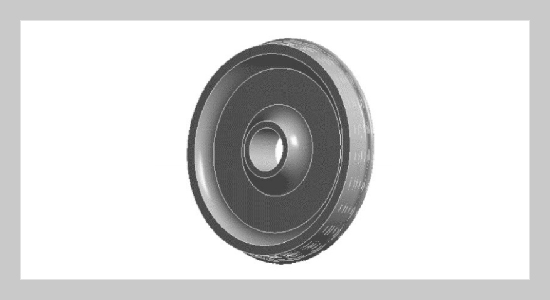REFERENCES
- [1] Wanming Zhai and Chunfa Zhao. Frontiers and challenges of sciences and technologies in modern railway engineering. Xinan Jiaotong Daxue Xuebao/Journal of Southwest Jiaotong University, 51(2):209–226, apr 2016.
- [2] F. Poisson, Pierre Etienne Gautier, and F. Letourneaux. Noise sources for high speed trains: A review of results in the TGV case. In Notes on Numerical Fluid Mechanics and Multidisciplinary Design, volume 99, pages 71–77, 2008.
- [3] D. J. Thompson. Wheel-rail noise generation, part III: Rail vibration. Journal of Sound and Vibration, 161(3):421– 446, 1993.
- [4] R. Stefanelli, J. Dual, and E. Cataldi-Spinola. Acoustic modelling of railway wheels and acoustic measurements to determine involved eigenmodes in the curve squealing phenomenon. Vehicle System Dynamics, 44(SUPPL. 1):286–295, 2006.
- [5] L. Han, X.A. Gu, X.Y. Wu, L.H. Liu, and Y.L. Li. Vibration and acoustic radiation characteristics of high-speed train wheels based on prestress. China Railway Science, 40(6):86–94, 2019.
- [6] X. W. Yang, G. T. Shi, and J. J. Yang. Effect of web hole on vibration noise radiation characteristics of railway wheel. China Railway Science, 35(2):58–64, 2014.
- [7] S. Yu, L. R. Zhou, and J. P. Ou. Finite Element Model Updating of Large Suspension Bridge Based on Radial Basis Function Response Surface. Journal of Railway Science and Engineering, 11(1):1–9, 2014.
- [8] Z. R. Kang, W. Zhang, S. Song, and J. B. Zhang. Experimental research on FE model updating of PC composite box girder bridge with corrugated steel webs based on response surface method. Journal of Railway Science and Engineering, 17(5):1186–1192, 2020.
- [9] X. N. Zou, J. X. Long, D. G. Yang, P. Hu, and Y. Han. Finite element model updating for a suspension bridge considering the boundary constraint conditions. Journal of Railway Science and Engineering, 16(5):1223–1230, 2019.
- [10] J. W. Zhan, M. Li, Y. Lu, and Z. Y. Yan. Dynamic evaluation method for damage of simply-supported beams based on model updating theory and FRF signature assurance criterion. China Civil Engineering Journal, 50(8):49–58, 2017.
- [11] Hamed Haddad Khodaparast, John E. Mottershead, and Kenneth J. Badcock. Interval model updating with irreducible uncertainty using the Kriging predictor. Mechanical Systems and Signal Processing, 25(4):1204–1226, 2011.
- [12] Jun Liang Hu, Quan Sheng Yan, Heng Bin Zheng, Nan Nan Cui, and Xiao Lin Yu. CFST arch/continuous beam bridge FEM model updating based on Kriging model. Zhendong yu Chongji/Journal of Vibration and Shock, 33(14):33–39, 2014.
- [13] Zhonghua Han. Kriging surrogate model and its application to design optimization: A review of recent progress, nov 2016.
- [14] Yin H., P. Cui, and Z. R. Peng. Model updating of frequency response function based on radial basis function. Chinese Journal of Computational Mechanics, 37(04):417–423, 2020.
- [15] Hong Yin, Jingjing Ma, Kangli Dong, Zhenrui Peng, Pan Cui, and Chenghao Yang. Model Updating Method Based on Kriging Model for Structural Dynamics. Shock and Vibration, 2019, 2019.
- [16] A. Hegde and J. Tang. Identifying parametric variation in second-order system from frequency response measurement. JVC/Journal of Vibration and Control, 24(5):879– 891, mar 2018.
- [17] Majid K Vakilzadeh, Vahid Yaghoubi, Anders T Johansson, and Thomas J.S. Abrahamsson. Stochastic finite element model calibration based on frequency responses and bootstrap sampling. Mechanical Systems and Signal Processing, 88:180–198, 2017.
- [18] Ning Guo, Zhichun Yang, You Jia, and Le Wang. Model updating using correlation analysis of strain frequency response function. Mechanical Systems and Signal Processing, 70-71:284–299, 2016.
- [19] J. T. Wang, C. J. Wang, and J. P. Zhao. Frequency response function-based model updating using Kriging model. Mechanical Systems and Signal Processing, 87:218– 228, 2017.
- [20] Z. R. Peng, M. M. Cao, and M. D. Liu. Model updating method based on wavelet decomposition of acceleration frequency response function. Acta Aeronautica et Astronautica Sinica, 41(7):181–191, 2020.
- [21] S. V. Modak, T. K. Kundra, and B. C. Nakra. Comparative study of model updating methods using simulated experimental data. Computers and Structures, 80(5-6):437–447, 2002.
- [22] Hadi Eskandar, Ali Sadollah, Ardeshir Bahreininejad, and Mohd Hamdi. Water cycle algorithm - A novel metaheuristic optimization method for solving constrained engineering optimization problems. Computers and Structures, 110-111:151–166, 2012.









